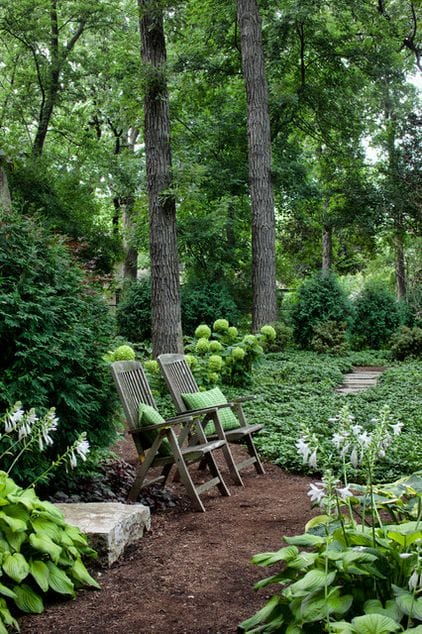Finding the Right Type of Gravel for Your Project in Austin, Texas
By Innovation Grounds
Are you longing for the tranquility and beauty of a forest right in your own backyard? With woodland landscaping, you can transform your outdoor space into a serene, nature-inspired haven that captures the essence of the woods. Whether you have a small backyard or a large estate, woodland landscaping offers a unique way to embrace the natural world and create a peaceful retreat. In this blog, we’ll explore the key elements of woodland landscaping and how you can bring the forest to your backyard.
What is Woodland Landscaping?
Woodland landscaping is a design style inspired by the natural beauty of forests and woodlands. It focuses on creating a low-maintenance, eco-friendly landscape that mimics the peaceful, organic feel of a wooded environment. The goal is to blend plants, trees, and natural features in a way that feels harmonious and effortless, as if the landscape has always been part of the surrounding forest.
Key elements of woodland landscaping include shaded areas, native plants, natural stone, and a mix of textures that evoke the forest floor. Whether you’re looking to recreate a dense forest or a light woodland glade, this style offers a variety of possibilities.

Choosing the Right Plants for Woodland Landscaping
One of the most important aspects of woodland landscaping is selecting the right plants that thrive in shady, woodland conditions. Unlike traditional gardens that often rely on full sunlight, woodland gardens focus on plants that flourish in low light and moist, well-drained soil.
Trees and Shrubs:
Start by incorporating trees that are typical of woodlands, such as oak, maple, beech, and birch. These trees provide shade and a sense of height, making your landscape feel more like a natural forest. Understory shrubs like azaleas, rhododendrons, and dogwoods can add color and variety.
Ground Covers and Ferns:
To create a lush, forest floor feel, use ground covers like moss, creeping thyme, or hostas. Ferns, such as Japanese painted fern or maidenhair fern, thrive in shaded conditions and can give your backyard an authentic woodland look.
Wildflowers:
Add wildflowers like bluebells, trillium, and columbine to introduce color and texture to your landscape. These native plants attract pollinators like bees and butterflies, enhancing the biodiversity of your woodland garden.

Incorporating Natural Features
Woodland landscaping isn’t just about plants—it’s about creating a holistic environment that mirrors the natural world. Here are a few ideas to help you incorporate natural elements into your design.
Stone Paths and Features:
Incorporate natural stone pathways to mimic forest trails. These paths will not only add aesthetic value but also serve as functional walkways. You can also add stone accents like rock walls or boulders to give your woodland garden a sense of permanence and natural beauty.
Water Features:
A small stream, pond, or even a birdbath can enhance the woodland feel and attract wildlife. The gentle sound of running water will create a calming atmosphere, reminiscent of a forest creek.
Mulch and Leaf Litter:
Woodland gardens often have a thick layer of mulch or leaf litter, which helps retain moisture and adds to the natural, earthy feel of the landscape. Using organic mulch such as bark chips or shredded leaves will help your garden mimic a real forest environment.

Designing a Woodland Landscape
When designing your woodland landscape, think about layering different heights and textures to create a sense of depth. Tall trees can provide structure, while shorter shrubs and ground covers create a natural undergrowth. Consider the space in your backyard and how you can design different zones, such as a shady retreat under a canopy of trees or a sun-dappled nook for relaxation.
Lighting is also important in woodland landscaping. Soft, ambient lighting placed strategically along paths or in trees can make your garden feel magical at night. Avoid harsh, bright lights, as they can disrupt the peaceful, natural atmosphere.

Benefits of Woodland Landscaping
Opting for woodland landscaping offers numerous benefits beyond just aesthetic appeal. Here are a few reasons why you might want to bring the forest to your backyard:
Low Maintenance: Woodland gardens are often easier to maintain because they require less watering and fertilizing compared to traditional gardens. Native plants are well-suited to the local climate, making them more resilient.
Wildlife Habitat: By using native plants, you can create a welcoming environment for birds, butterflies, and other wildlife, contributing to local biodiversity.
Eco-Friendly: Woodland landscaping promotes sustainability by using natural materials and reducing the need for chemical fertilizers or pesticides.
Increased Property Value: A thoughtfully designed woodland landscape can increase the curb appeal and overall value of your property, offering a beautiful and unique outdoor space that potential buyers will appreciate.

Conclusion
Woodland landscaping is a perfect way to bring the peaceful, natural beauty of the forest right into your own backyard. By incorporating native plants, natural features, and eco-friendly elements, you can create a stunning, low-maintenance landscape that mimics the charm of a forest setting. Whether you’re looking to design a shady retreat or a lush woodland paradise, woodland landscaping offers endless possibilities for transforming your outdoor space into a serene, nature-inspired oasis.
So, why not start today? With the right plants, materials, and design, you can bring the forest to your backyard and enjoy the peaceful beauty of woodland landscaping all year long.


